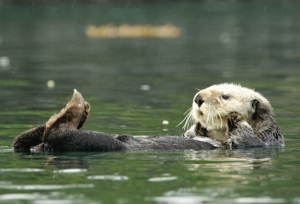Are Otter-Inspired Wet Suits on the Horizon?

By Mary Rose Thomas Glaser
Divers are well aware of the dangers of hypothermia, even in warm waters and mild temperatures, since water pulls heat from a body 25 times faster than air. To help keep divers warm, wet suits minimize thermal transfer of heat away from the diver’s body by trapping a thin layer of water between the suit and diver’s skin and preventing cold, outside water from seeping in. Yet these suits are limited in their ability to keep divers warm for extended times in colder waters.
How Do Marine Animals Stay Warm?
Marine animals have physically adapted to their environment and can thrive in freezing waters. Whales, seals and porpoises maintain thick layers of insulating blubber. Other animals, like the sea otter, are insulated from the cold waters by fur.
Sea otters are born in the cold waters along the Pacific coasts of North America and Asia and spend most of their lives in the water, floating and even sleeping on their backs. And they maintain a constant toasty body temperature of 100°F without a layer of blubber.
What’s So Special About Otter Fur?
The secret to their warmth lies in their super dense, water-repellent fur that traps air and prevents water from contacting their skin. In fact, otter fur is so dense that in just one square inch there are a million hairs. The average human head has about 100,000 to 150,000 hairs.
In addition, otter guard hairs have two key features. They are longer and coarser with an ovoid, rather than circular, cross section that allows them to flatten in the same direction when wet. They also have minute, scale-like projections that lock hairs together to keep water out.
Using these features, researchers are exploring the water repellency of surfaces covered with rigid, squat projections. In a series of experiments, a team altered the length and spacing of projections and found that surfaces with longer, more densely packed protrusions trapped air best — just like otter fur. They plan to continue experiments to develop materials with surfaces that more closely mirror synthetic fur and explore potential practical applications — perhaps even wet suits made with artificial fur.
Classroom Discussion
- What is biomimicry? What everyday products have been developed using biomimicry?
- How does cold water pull heat from the human body?
Vocabulary
- Blubber
- Guard hair